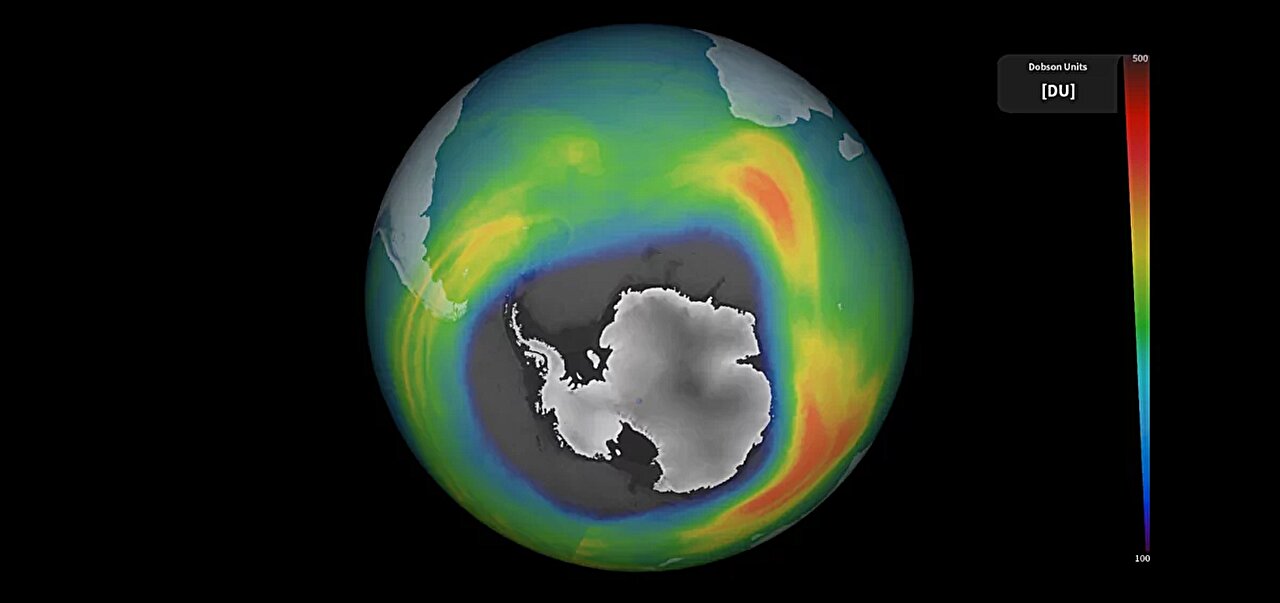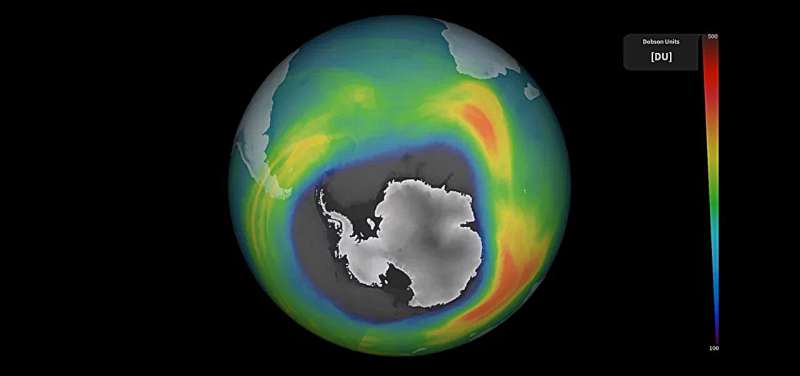

In 1974, scientists first sounded the alarm about the destruction of the ozone layer caused by human activities. Yet it would take several more years for the global community to reach a consensus on banning ozone-depleting chemicals.
At the time, Paul Crutzen and his research team played a pivotal role in bringing this issue to the world’s attention. Today, the ozone hole is slowly healing, but progress is being hampered by the growing challenges of climate change.
In late November 1987, an issue of the German news magazine Der Spiegel sent shockwaves through the public. The headline the “The Ozone Hole” was emblazoned across the cover in large letters, set against a blue sky pierced by a gaping black hole and a giant spray can. This moment marked the first time that the German public truly grasped the severity of the situation: Earth was on the brink of an environmental catastrophe.
Just weeks earlier, the ozone layer over Antarctica had disintegrated across an enormous area for the first time—a crucial layer that, at 15 to 25 kilometers above the Earth’s surface, acts as a protective shield in the atmosphere, filtering out harmful ultraviolet (UV) radiation from space. According to Der Spiegel, research flights had revealed that the ozone hole had expanded to an area the size of the United States.
In South America, sheep farmers reported their livestock going blind due to heightened UV exposure, and in Australia, TV stations began warning sunbathers about “Today’s burning time”—the minutes until sunburn would occur.
The fate of the Earth seemed sealed: unfiltered UV radiation would soon pour down, devastating plants and animals, and destroying human food supplies. Rates of skin cancer were projected to soar to unprecedented levels.
Yet, as early as 1974, scientists had already raised the alarm about the destruction of the ozone layer. Chemists Mario Molina and Frank Sherwood Rowland had published a hypothesis in the journal Nature, suggesting that chemicals used as propellants in spray cans and related compounds—known as chlorofluorocarbons (CFCs) or halons—were accumulating in the stratosphere and depleting the ozone layer.
They proposed that this destruction was occurring in the upper stratosphere at around 40 kilometers above the Earth. While their estimates were off by about 20 kilometers, their core idea was correct. It would take years, however, before conclusive evidence emerged and the global effort to combat CFCs gained momentum. The first ozone hole was detected over Antarctica in 1985, and it wasn’t until 2020 that a similar hole was observed over the Arctic.
NASA research flights
Inspired by Molina and Rowland’s Nature article, research teams worldwide turned their attention to the issue of ozone depletion, including Paul Crutzen’s group at the Max Planck Institute for Chemistry in Mainz. Crutzen, who passed away in January 2021, would go on to share the 1995 Nobel Prize in Chemistry with Molina and Rowland for their contributions to understanding the chemistry of the ozone layer.
Ozone had already been a subject of meteorological research for some time, as its concentration naturally fluctuates in the atmosphere. But the chemical processes driving these changes were not fully understood.
Chemist Christoph Brühl, who joined Crutzen’s group as a Ph.D. student in the early 1980s, recalls the period of intense investigation. “My colleague Susan Solomon, in collaboration with NASA, conducted extensive research flights to measure ozone, CFCs, and other gases on-site—these provided vital and unique data for our models.”
These on-site measurements allowed researchers to test Crutzen’s theory that CFCs were driving ozone depletion through catalytic cycles—chemical reactions in which ozone molecules are continuously broken down in a chain reaction. At the time, scientists were already familiar with natural catalytic cycles that contributed to ozone depletion, particularly those driven by nitrogen monoxide (NO) and nitrogen dioxide (NO₂).
NO and NO₂ can reach the stratosphere through emissions from aircraft or form there via chemical reactions, such as from agricultural nitrous oxide. In these cycles, ozone (O₃) is destroyed when NO reacts with it, producing nitrogen dioxide (NO₂) and oxygen (O₂). Sunlight then splits NO₂ back into NO and oxygen (O), allowing the cycle to continue and further deplete ozone.
Crutzen’s significant contribution was in applying this catalytic cycle model to CFCs, where chlorine atoms break down ozone molecules one by one.
The role of clouds
Interestingly, ozone depletion pauses during the months-long polar night. However, as the polar night ends in both Antarctica and the Arctic, the destructive process resumes with full intensity. Crutzen’s team discovered why: Polar stratospheric clouds (PSCs), which form in extreme cold during polar nights, are a key factor.
The first sunlight of spring triggers a chain reaction on the surface of these clouds, initiating chlorine-based ozone destruction. The problem is exacerbated by unique meteorological conditions in polar regions that prevent the mixing of different air masses, allowing the ozone-depleting reactions to proceed largely unchecked.
Initially, the chemical industry denied any link between CFCs and the ozone hole. However, with the publication of Crutzen’s findings as well as the work of other scientists, the connection became undeniable. This growing body of evidence spurred one of the most successful global environmental protection efforts in history.
In 1987, countries around the world signed the Montreal Protocol, which went into effect in 1989 and banned the production and use of ozone-depleting substances. Over the following years, these harmful chemicals were gradually phased out and replaced with more environmentally friendly alternatives.
Wildfires damage the ozone layer
And that’s not all. Brühl’s former colleague Susan Solomon, now at the Massachusetts Institute of Technology, has analyzed the impact of the devastating Australian wildfires in 2019 and 2020 more closely. Her team discovered that hydrochloric acid molecules, residuals from CFCs, adhere to the surfaces of smoke particles from the fires.
These particles react with other substances, releasing chlorine molecules. When exposed to sunlight, these chlorine molecules break down into highly reactive chlorine radicals, which then rapidly destroy ozone molecules. “After these fires, the stratosphere looked like a different planet,” Solomon noted in 2023.
The power of trace gases
“We’ve long known that the ozone layer is sensitive to various trace gases, even at low concentrations,” says Brühl. In the 1970s, for example, Crutzen warned that supersonic aircraft like the Concorde could damage the ozone layer by releasing nitrogen oxides. At that time, the prospect of frequent supersonic flights between continents seemed imminent. Because these planes flew directly through the stratosphere, this could have had disastrous effects.
Similarly, when NASA’s Space Shuttles, with their large boosters, began launching in the 1980s, data indicated a notable drop in ozone levels within hundreds of kilometers of their flight paths. Given these precedents, Brühl remains cautious about the current recovery of the ozone layer.
Major volcanic eruptions also contribute to ozone depletion. These events release enormous amounts of sulfur and other compounds into the stratosphere, which harm the ozone layer. The January 2022 eruption of the Hunga Tonga-Hunga Haʻapai volcano in Tonga, for instance, sent massive amounts of material into the stratosphere.
“The effects on the ozone layer are still measurable,” says Brühl. Despite these ongoing challenges, there is some encouraging news: The ozone holes over Antarctica and the Arctic, sometimes extending as far as north-western Europe, are gradually shrinking. The only remaining question is how long it will take for the effects of CFCs to fully dissipate.
Provided by
Max Planck Society
Citation:
How is the hole in the ozone layer? (2024, September 16)
retrieved 16 September 2024
from https://phys.org/news/2024-09-hole-ozone-layer.html
This document is subject to copyright. Apart from any fair dealing for the purpose of private study or research, no
part may be reproduced without the written permission. The content is provided for information purposes only.